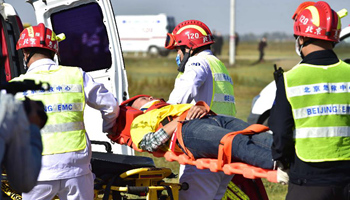GENEVA, Sept. 13 (Xinhua) -- The yellow fever outbreaks are under control in Angola and the Democratic Republic of the Congo (DRC) due to completion of massive vaccination campaigns in the two countries, an expert from the World Health Organization (WHO) said Tuesday.
"Those outbreaks were under control now, and there had not been any new cases in Angola since June 23, and since July 12 in DRC," Sylvie Briand, director of WHO Infectious Hazard Management, told a press conference after WHO convened a meeting focused on yellow fever strategies for the future.
Recently there had been major mass vaccination campaigns to stop the transmission of the virus, but also pre-emptive efforts to make sure that the transmission would not start again with the beginning of the rainy season, which was imminent.
According to the expert, 7 million people had been vaccinated in DRC's capital city if Kinshasa in less than 10 days. Another 3 million people had been vaccinated in the area of the border with Angola, to prevent transmission from the provinces of Angola which had been affected.
On the other side of the border, in Angola, around 3 million people had already been vaccinated as part of a first mass vaccination campaign.
In total, more than 15 million people had been vaccinated so far in Angola, which represented 65 percent of the population.
"It was still necessary to better protect certain districts and provinces, but the risk of a major outbreak was now over," Briand said.
Briand said the risk of yellow fever had increased in the recent past since intense urbanization in Africa, increasing mobility of the populations within the countries affected as well as between those countries and the rest of the world, due to disasters, conflicts but also professional mobility.
Also, the El Nino phenomenon was responsible for heavy rains, spurring higher mosquito densities, especially in urban settings.
With 32 yellow fever endemic countries in Africa, Briand warned there were still areas at risk. In DRC, beyond the capital and the border provinces where vaccination campaigns had been led, the rest of the country was still at risk.










